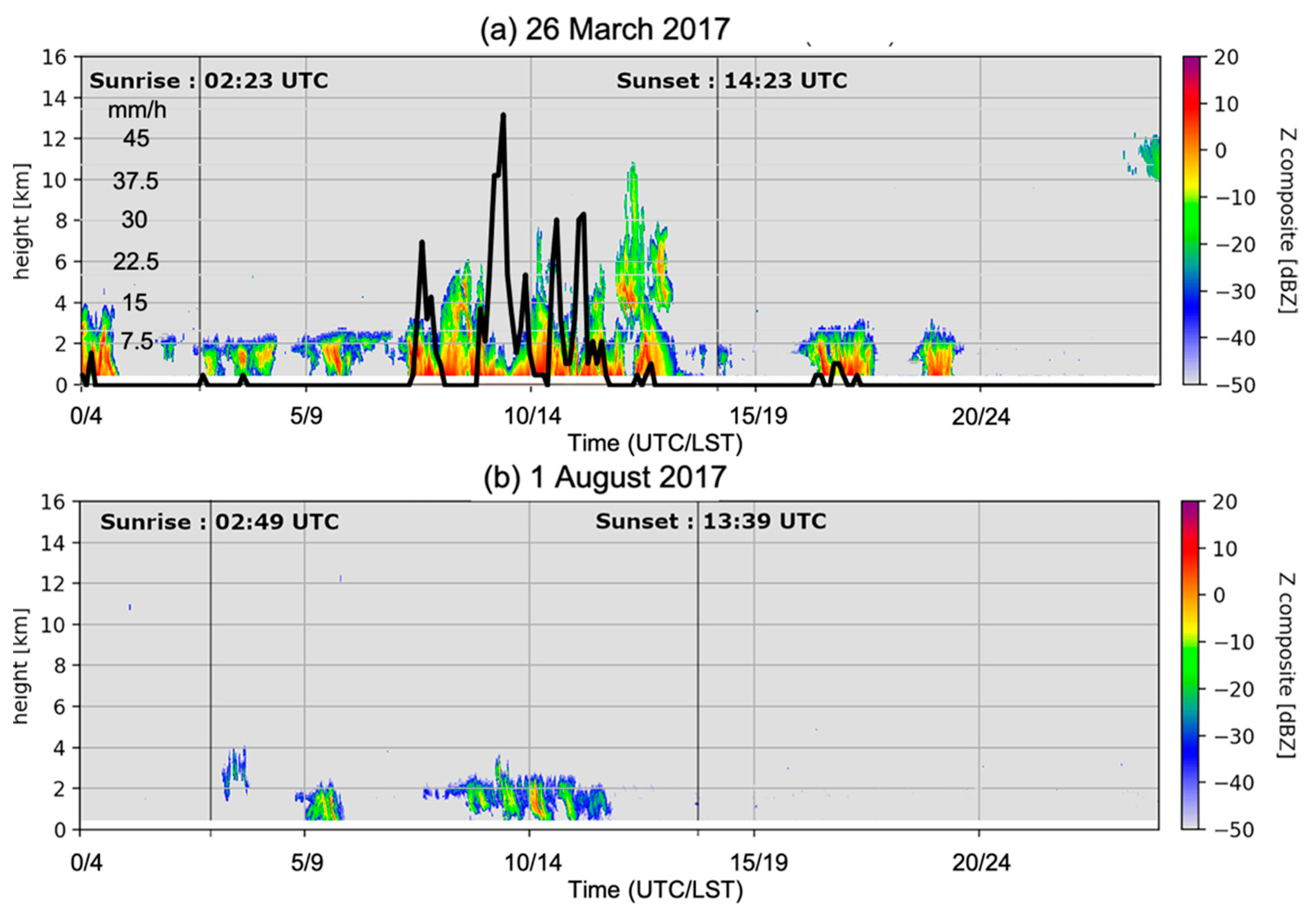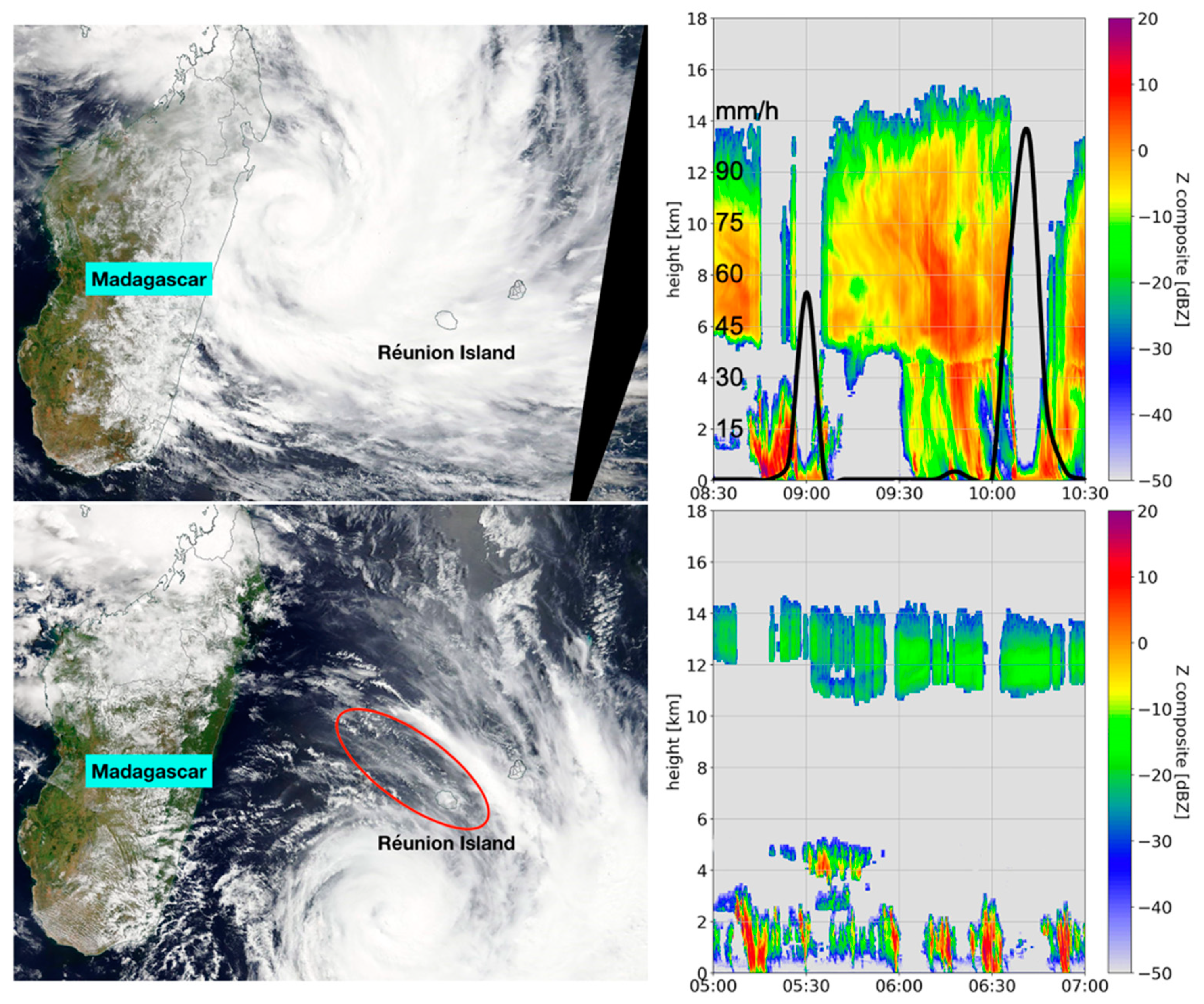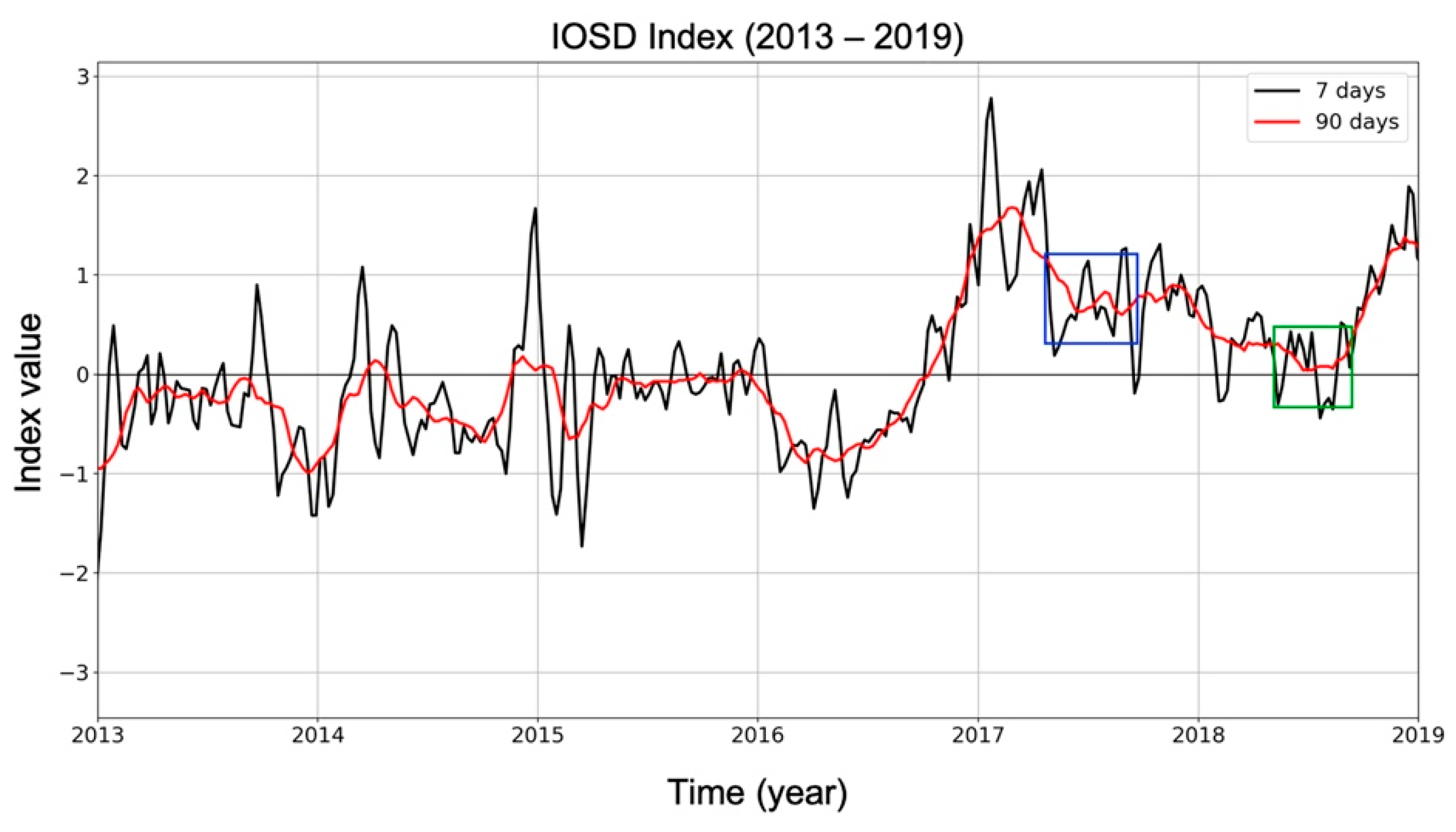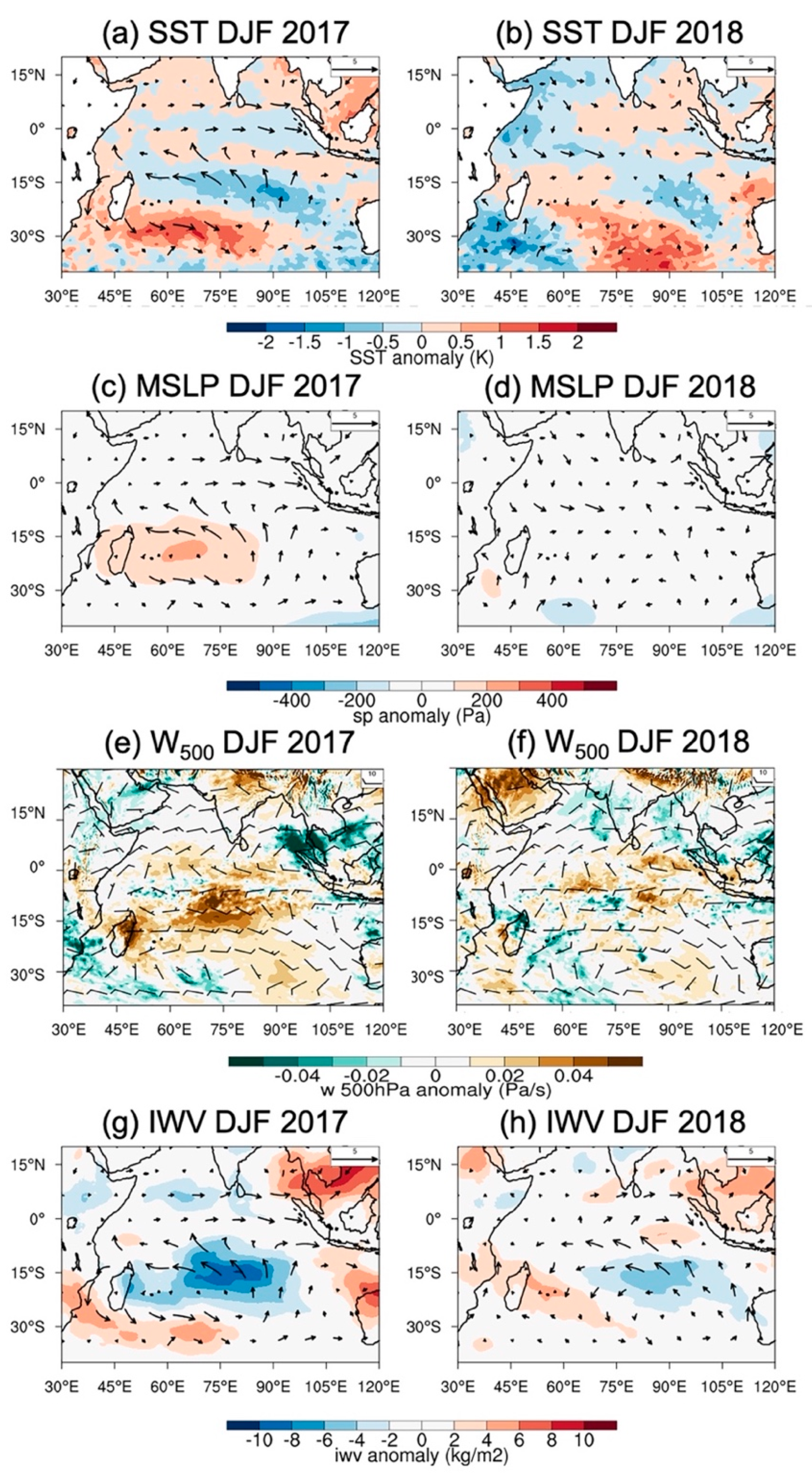Cloud Radar Observations of Diurnal and Seasonal Cloudiness over Reunion Island
Abstract
:1. Introduction
2. Data and Methods
2.1. Cloud Radar Observations
2.2. Other Datasets
- (i)
- In situ observations of relative humidity inferred from Saint-Denis’ airport (20.88° S, 55.51° E) operational daily radiosounding data collected between 2014 and 2018;
- (ii)
- Time series of integrated water vapor (IWV) columns, inferred from the analysis of GNSS data collected from the IGN (Institut Geographique National) station STDE (20.88° S–55.51° E) and the International GNSS System (IGS)’ station REUN (21.2° S, 55.57° E). GNSS data are processed following the approach used by [34,35] to produce IWV data at various locations in the SWIO basin (a complete description of GNSS IWV retrieval and associated uncertainties can be found in the former papers).
- (iii)
- Reanalysis data extracted from European Center for Medium-Range Weather Forecast (ECMWF)’s 5th generation reanalysis (ERA5) are used to investigate the regional atmospheric conditions prevailing over the SWIO basin. ERA5 provides hourly estimates of numerous atmospheric, land and oceanic climate variables on a 0.25 × 0.25° horizontal grid [36]. Reanalysis data used in this study consist of wind, humidity, sea level pressure and vertical velocity fields extracted over the period 1990–2020.
3. Diurnal and Seasonal Variability of Cloudiness over Saint-Denis in 2017 and 2018
Diurnal Cycle
4. Analysis of Local and Large-Scale Environmental Conditions Prevailing in 2017 and 2018
4.1. IOSD Patterns
4.2. Large Scale Anomalies
4.3. Local Observations
5. Discussion and Conclusions
Author Contributions
Funding
Institutional Review Board Statement
Informed Consent Statement
Data Availability Statement
Acknowledgments
Conflicts of Interest
References
- Liou, K.-N. Influence of Cirrus Clouds on Weather and Climate Processes: A Global Perspective. Mon. Weather. Rev. 1986, 114, 1167–1199. [Google Scholar] [CrossRef]
- Hansen, J.; Sato, M.; Ruedy, R. Radiative forcing and climate response. J. Geophys. Res. Space Phys. 1997, 102, 6831–6864. [Google Scholar] [CrossRef]
- Klein, S.A.; Hall, A.; Norris, J.R.; Pincus, R. Low-Cloud Feedbacks from Cloud-Controlling Factors: A Review. Surv. Geophys. 2017, 38, 1307–1329. [Google Scholar] [CrossRef] [Green Version]
- Bony, S. Marine boundary layer clouds at the heart of tropical cloud feedback uncertainties in climate models. Geophys. Res. Lett. 2005, 32, 20806. [Google Scholar] [CrossRef] [Green Version]
- Stephens, G.L. Cloud Feedbacks in the Climate System: A Critical Review. J. Clim. 2005, 18, 237–273. [Google Scholar] [CrossRef] [Green Version]
- Nuijens, L.; Stevens, B.; Siebesma, A.P. The Environment of Precipitating Shallow Cumulus Convection. J. Atmos. Sci. 2009, 66, 1962–1979. [Google Scholar] [CrossRef] [Green Version]
- Madden, R.; Julian, P. Detection of a 40-50-day oscillation of the zonal wind in the tropical Pacific. J. Atmos. Sci. 1971, 28, 702–708. [Google Scholar] [CrossRef]
- Madden, R.; Julian, P. Observations of the 40–50-day tropical oscillation. A review. Mon. Wea. Rev. 1994, 122, 814–837. [Google Scholar] [CrossRef]
- Battaglia, A.; Kollias, P.; Dhillon, R.; Lamer, K.; Khairoutdinov, M.; Watters, D. Mind the gap–Part 2: Improving quantitative estimates of cloud and rain water path in oceanic warm rain using spaceborne radars. Atmos. Meas. Tech. 2020, 13, 4865–4883. [Google Scholar] [CrossRef]
- Marchand, R.; Mace, G.G.; Ackerman, T.; Stephens, G. Hydrometeor Detection Using Cloudsat—An Earth-Orbiting 94-GHz Cloud Radar. J. Atmos. Ocean. Technol. 2008, 25, 519–533. [Google Scholar] [CrossRef]
- Sassen, K.; Wang, Z. Classifying clouds around the globe with the CloudSat radar: 1-year of results. Geophys. Res. Lett. 2008, 35, 04805. [Google Scholar] [CrossRef]
- Lamer, K.; Kollias, P.; Battaglia, A.; Preval, S. Mind the gap–Part 1: Accurately locating warm marine boundary layer clouds and precipitation using spaceborne radars. Atmos. Meas. Tech. 2020, 13, 2363–2379. [Google Scholar] [CrossRef]
- Kollias, P.; Clothiaux, E.E.; Miller, M.A.; Albrecht, B.A.; Stephens, G.L.; Ackerman, T.P. Millimeter-Wavelength Radars: New Frontier in Atmospheric Cloud and Precipitation Research. Bull. Am. Meteorol. Soc. 2007, 88, 1608–1624. [Google Scholar] [CrossRef] [Green Version]
- Long, C.N.; Mather, J.H.; Ackerman, T.P. The ARM Tropical Western Pacific (TWP) Sites. Meteorol. Monogr. 2016, 57, 7. [Google Scholar] [CrossRef]
- Thorsen, T.J.; Fu, Q.; Comstock, J. Cloud effects on radiative heating rate profiles over Darwin using ARM and A-train radar/lidar observations. J. Geophys. Res. Atmos. 2013, 118, 5637–5654. [Google Scholar] [CrossRef]
- Liu, Z.; Marchand, R.; Ackerman, T. A comparison of observations in the tropical western Pacific from ground-based and satellite millimeter-wavelength cloud radars. J. Geophys. Res. Space Phys. 2010, 115. [Google Scholar] [CrossRef]
- Bouniol, D.; Couvreux, F.; Kamsu-Tamo, P.; Leplay, M.; Guichard, F.; Favot, F.; O’Connor, E.J. Diurnal and Season-al Cycles of Cloud Occurrences, Types, and Radiative Impact over West Africa. J. Appl. Meteorol. Clim. 2012, 51, 534–553. [Google Scholar] [CrossRef] [Green Version]
- Sukanya, P.; Kalapureddy, M.C.R. Cloud radar observations of multi-scale variability of cloud vertical structure associated with Indian summer monsoon over a tropical location. Clim. Dyn. 2021, 56, 1055–1081. [Google Scholar] [CrossRef]
- Stevens, B.; Farrell, D.; Hirsch, L.; Jansen, F.; Nuijens, L.; Serikov, I.; Brügmann, B.; Forde, M.; Linné, H.; Lonitz, K.; et al. The Barbados Cloud Observatory: Anchoring Investigations of Clouds and Circulation on the Edge of the ITCZ. Bull. Am. Meteorol. Soc. 2016, 97, 787–801. [Google Scholar] [CrossRef]
- Stevens, B.D.; Bony, S.; Farrell, D.; Ament, F. EUREC4A, submitted to Earth. Sys. Sci. Data. 2021. Available online: https://essd.copernicus.org/preprints/essd-2021-18/ (accessed on 29 May 2021).
- Brueck, M.; Nuijens, L.; Stevens, B. On the Seasonal and Synoptic Time-Scale Variability of the North Atlantic Trade Wind Region and Its Low-Level Clouds. J. Atmos. Sci. 2015, 72, 1428–1446. [Google Scholar] [CrossRef]
- Kollias, P.; Bharadwaj, N.; Clothiaux, E.E.; Lamer, K.; Oue, M.; Hardin, J.; Isom, B.; Lindenmaier, I.; Matthews, A.; Luke, E.; et al. The ARM Radar Network: At the Leading Edge of Cloud and Precipitation Observations. Bull. Am. Meteorol. Soc. 2020, 101, E588–E607. [Google Scholar] [CrossRef] [Green Version]
- Baray, J.-L.; Courcoux, Y.; Keckhut, P.; Portafaix, T.; Tulet, P.; Cammas, J.-P.; Hauchecorne, A.; Godin Beekmann, S.; De Mazière, M.; Hermans, C.; et al. Maïdo observatory: A new high-altitude station facility at Reunion Island (21° S, 55° E) for long-term atmospheric remote sensing and in situ measurements. Atmos. Meas. Tech. 2013, 6, 2865–2877. [Google Scholar] [CrossRef] [Green Version]
- Delanoë, J.; Protat, A.; Vinson, J.-P.; Brett, W.; Caudoux, C.; Bertrand, F.; Du Chatelet, J.P.; Hallali, R.; Barthes, L.; Haeffelin, M.; et al. BASTA: A 95-GHz FMCW Doppler Radar for Cloud and Fog Studies. J. Atmos. Ocean. Technol. 2016, 33, 1023–1038. [Google Scholar] [CrossRef] [Green Version]
- Bergemann, M.; Jakob, C. How important is tropospheric humidity for coastal rainfall in the tropics? Geophys. Res. Lett. 2016, 43, 5860–5868. [Google Scholar] [CrossRef]
- Dupont, J.-C.; Haeffelin, M.; Wærsted, E.; Delanoe, J.; Renard, J.-B.; Preissler, J.; O’Dowd, C. Evaluation of Fog and Low Stratus Cloud Microphysical Properties Derived from In Situ Sensor, Cloud Radar and SYRSOC Algorithm. Atmosphere 2018, 9, 169. [Google Scholar] [CrossRef] [Green Version]
- Quetelard, H.; Bessemoulin, P.; Cerveny, R.S.; Peterson, T.C.; Burton, A.; Boodhoo, Y. Extreme Weather: World-Record Rainfalls During Tropical Cyclone Gamede. Bull. Am. Meteorol. Soc. 2009, 90, 603–608. [Google Scholar] [CrossRef]
- Taupin, F.G.; Bessafi, M.; Baldy, S.; Bremaud, P.J. Tropospheric ozone above the southwestern Indian Ocean is strongly linked to dynamical conditions prevailing in the tropics. J. Geophys. Res. Space Phys. 1999, 104, 8057–8066. [Google Scholar] [CrossRef]
- Brémaud, P.; Taupin, F. Cloud influence on ozone diurnal cycle in the marine boundary layer at Réunion Island. Atmos. Res. 1998, 47–48, 285–298. [Google Scholar] [CrossRef]
- Lesouëf, D.; Gheusi, F.; Delmas, R.; Escobar, J. Numerical simulations of local circulations and pollution transport over Reunion Island. Ann. Geophys. 2011, 29, 53–69. [Google Scholar] [CrossRef] [Green Version]
- Réchou, A.; Flores, O.; Jumaux, G.; Duflot, V.; Bousquet, O.; Pouppeville, C.; Bonnardot, F. Spatio-temporal variability of rainfall in a high tropical island: Patterns and large-scale drivers in Réunion Island. Q. J. R. Meteorol. Soc. 2019, 145, 893–909. [Google Scholar] [CrossRef]
- Rechou, A.; Rao, T.N.; Bousquet, O.; Plu, M.; Decoupes, R. Properties of rainfall in a tropical volcanic island deduced from UHF wind profiler measurements. Atmos. Meas. Tech. 2014, 7, 409–418. [Google Scholar] [CrossRef] [Green Version]
- Jumeaux, G.; Quetelard, H.; Roy, D. Atlas Climatique de La Réunion of Météo-France, Météo-France technical report 2011. (in French). Available online: http://www.meteofrance.fr/publications/nos-collections/climat-outre-mer/atlas-climatique-de-la-reunion (accessed on 29 May 2021).
- Lees, E.; Bousquet, O.; Roy, D.; Leclair, J. Analysis of diurnal to seasonal variability of integrated water vapour in the South Indian Ocean basin using ground-based GNSS and 5th generation ECMWF reanalysis (ERA5) data. Q. J. R. Meteorol. 2021, 147, 229–248. [Google Scholar] [CrossRef]
- Bousquet, O.; Lees, E.; Durand, J.; Peltier, A.; Duret, A.; Mekies, D.; Boissier, P.; Donal, T.; Fleischer-Dogley, F.; Zakariasy, L. Densification of the Ground-Based GNSS Observation Network in the Southwest Indian Ocean: Current Status, Perspectives, and Examples of Applications in Meteorology and Geodesy. Front. Earth Sci. 2020, 8. [Google Scholar] [CrossRef]
- Hersbach, H.; Bell, B.; Berrisford, P.; Hirahara, S.; Horanyi, A.; Muñoz-Sabater, J.; Nicolas, J.; Peubey, C.; Radu, R.; Schepers, D.; et al. The ERA5 global reanalysis. Q. J. R. Meteorol. Soc. 2020, 146, 1999–2049. [Google Scholar] [CrossRef]
- Behera, S.; Yamagata, T. Subtropical SST dipole events in the southern Indian Ocean. Geophys. Res. Lett. 2001, 28, 327–330. [Google Scholar] [CrossRef]
- Bousquet, O.; Barbary, D.; Bielli, S.; Kebir, S.; Raynaud, L.; Malardel, S.; Faure, G. An evaluation of tropical cyclone forecast in the Southwest Indian Ocean basin with AROME-Indian Ocean convection-permitting numerical weather predicting system. Atmos. Sci. Lett. 2019, 21, 950. [Google Scholar] [CrossRef]
- Hogan, R.J.; O’Connor, E.J.; Illingworth, A.J. Verification of cloud-fraction forecasts. Q. J. R. Meteorol. Soc. 2009, 135, 1494–1511. [Google Scholar] [CrossRef]
- Protat, A.; Bouniol, D.; Delanoë, J.; May, P.T.; Plana-Fattori, A.; Hasson, A.; Görsdorf, U.; Heymsfield, A.J. As-sessment of Cloudsat Reflectivity Measurements and Ice Cloud Properties Using Ground-Based and Airborne Cloud Radar Observations. J. Atmos. Ocean. Technol. 2009, 26, 1717–1741. [Google Scholar] [CrossRef] [Green Version]
- Bousquet, O.; Barruol, G.; Cordier, E.; Barthe, C.; Bielli, S.; Calmer, R.; Rindraharisaona, E.; Roberts, G.; Tulet, P.; Amelie, V.; et al. Impact of Tropical Cyclones on Inhabited Areas of the SWIO Basin at Present and Future Horizons. Part 1: Overview and Observing Component of the Research Project RENOVRISK-CYCLONE. Atmosphere 2021, 12, 544. [Google Scholar] [CrossRef]
- Illingworth, A.J.; Barker, H.W.; Beljaars, A.; Ceccaldi, M.; Chepfer, H.; Clerbaux, N.; Cole, J.; Delanoë, J.; Domènech, C.; Donovan, D.P.; et al. The EarthCARE Satellite: The Next Step Forward in Global Measurements of Clouds, Aerosols, Precipitation, and Radiation. Bull. Am. Meteorol. Soc. 2015, 96, 1311–1332. [Google Scholar] [CrossRef] [Green Version]











Publisher’s Note: MDPI stays neutral with regard to jurisdictional claims in published maps and institutional affiliations. |
© 2021 by the authors. Licensee MDPI, Basel, Switzerland. This article is an open access article distributed under the terms and conditions of the Creative Commons Attribution (CC BY) license (https://creativecommons.org/licenses/by/4.0/).
Share and Cite
Durand, J.; Lees, E.; Bousquet, O.; Delanoë, J.; Bonnardot, F. Cloud Radar Observations of Diurnal and Seasonal Cloudiness over Reunion Island. Atmosphere 2021, 12, 868. https://doi.org/10.3390/atmos12070868
Durand J, Lees E, Bousquet O, Delanoë J, Bonnardot F. Cloud Radar Observations of Diurnal and Seasonal Cloudiness over Reunion Island. Atmosphere. 2021; 12(7):868. https://doi.org/10.3390/atmos12070868
Chicago/Turabian StyleDurand, Jonathan, Edouard Lees, Olivier Bousquet, Julien Delanoë, and François Bonnardot. 2021. "Cloud Radar Observations of Diurnal and Seasonal Cloudiness over Reunion Island" Atmosphere 12, no. 7: 868. https://doi.org/10.3390/atmos12070868
APA StyleDurand, J., Lees, E., Bousquet, O., Delanoë, J., & Bonnardot, F. (2021). Cloud Radar Observations of Diurnal and Seasonal Cloudiness over Reunion Island. Atmosphere, 12(7), 868. https://doi.org/10.3390/atmos12070868




